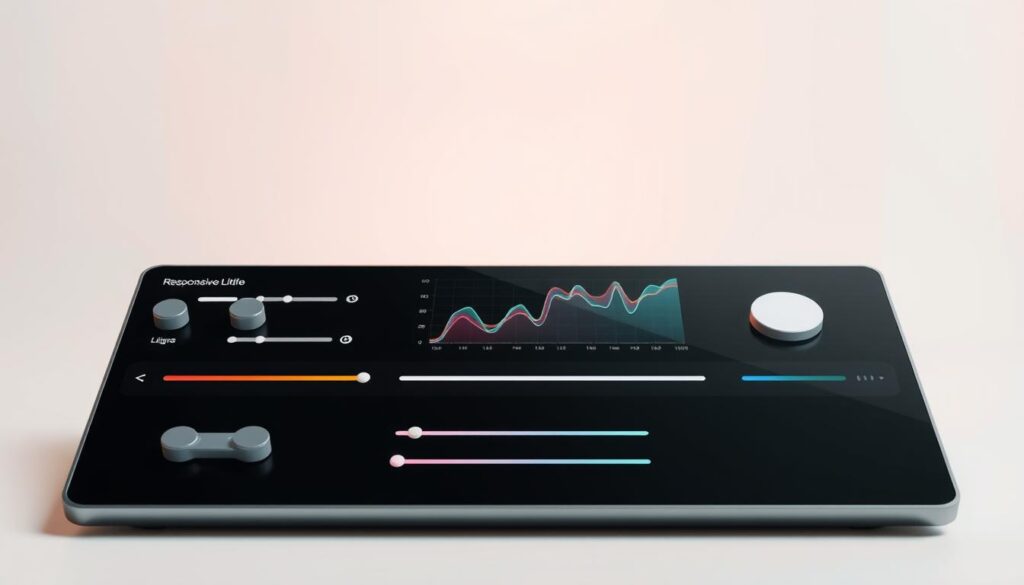70% of buyers convert with interactive formats versus 36% for passive posts. That gap explains why static content stalls high-ticket sales cycles and inflates CAC for premium brands.
We solve that problem by turning passive scrollers into decisive participants. Our approach uses polls, quizzes, calculators, AR filters, and video tools to drive measurable engagement and capture intent signals at the source.
We collect declared preferences and qualification data that feed CRM and speed up deals. This creates clear ROI: better segmentation, personalization, and faster internal buy-in for complex offers.
Brands like Sephora and IKEA already use AR to lift reach and CTR, while Facebook’s Instant Experience ads prove richer formats deepen response. We combine those examples with governance, integration, and the WebberXSuite™ framework so leaders see results, not vanity metrics.
Key Takeaways
- Static content underperforms for premium categories; richer formats drive conversion lift and time on page.
- We prioritize declared data capture to qualify users and reduce sales friction.
- Proven formats—quizzes, calculators, AR, and interactive video—boost engagement and shareability.
- Executive outcomes include precise segmentation, dynamic offers, and stakeholder-ready visuals.
- Macro Webber delivers turnkey frameworks and integrations to protect brand and scale results—book a consult to see the Growth Blueprint.
The state of engagement right now: why static content is losing and interactivity wins
Attention spans have collapsed—today’s feeds reward participation, not passive viewing. Static content suffers banner blindness. Feed algorithms favour posts that spark action and time on page.
We see the evidence in plain numbers: interactive formats deliver roughly twice the conversions of passive posts. Mediafly reports a 52.6% lift in engagement, and Demand Metric finds 70% conversion for active formats versus 36% for passive. Social posts with interactive elements attract up to 4x more interactions.

From banner blindness to active participation: the shift in user behavior
Users expect control and instant payoff. Polls, quizzes, and quick assessments provide that reward. They convert impressions into declared preferences and usable data.
Key stats that matter to high-ticket brands: engagement, conversion, and differentiation
- 52.6% higher engagement for interactive formats (Mediafly).
- 70% vs 36% conversion advantage over passive posts (Demand Metric).
- Adoption nearly doubled from 2023–2024; 88% of marketers credit it with brand differentiation.
Executive takeaway: we must replace passive broadcasts with guided experiences that surface preferences in real time. Doing so reduces wasted spend, speeds pipeline velocity, and feeds cleaner data into CRM for smarter follow-up.
Interactive Content Marketing defined and why it matters for scalable growth
Our definition centers on tools that prompt answers and deliver personalized guidance in real time. We design experiences that ask simple questions and return immediate value—recommendations, estimates, or tailored paths that move buyers forward.

What counts as these formats
- Quizzes & assessments: fast segmentation and product-fit signals.
- Calculators & configurators: instant estimates that qualify intent.
- Polls & surveys: lightweight preference capture for A/B decisions.
- Interactive infographics & maps: simplify complex data for executives.
- AR/VR try-ons and video with branching logic: immersive demos that prove product value.
How interactivity fuels data, insights, and better decisions
Every reply yields declared data—budget ranges, timelines, objections, and product preferences. That data creates actionable insights for segmentation and prioritization.
“Structured questions convert passive viewers into qualified leads and clear next steps.”
- Full-funnel utility: awareness (polls, quizzes), consideration (calculators, maps), decision (quotes, assessments).
- Operational payoff: map answers to CRM fields to automate scoring and routing.
- Education advantage: flows teach complex features step-by-step, increasing executive buy-in.
Bottom line: Replace static content handoffs with responsive elements that adapt to answers. The result is higher engagement, better data quality, and faster pipeline velocity.
High-impact formats that convert: polls, quizzes, AR filters, calculators, and interactive infographics
Well-designed tools convert curiosity into declared intent and clear next steps.
Quizzes and assessments segment audiences quickly. Deploy a “Which solution fits your org?” flow to map budget, timeline, and role. Use logic jumps to present tailored outcomes and CTAs.
Polls and surveys capture preference signals with minimal friction. Embed 1–2 click items on landing pages or stories to test messaging and iterate offers based on live feedback.
Calculators and quote tools deliver instant value and qualify buyers. ROI and TCO estimators (Upwork’s budget tool as an example) nudge users toward contact and feed CRM for precise routing.
- Interactive infographics: clickable maps and hover states translate complex metrics for executives (The New York Times uses this well).
- AR filters / virtual try-ons: Sephora and IKEA show how immersion lifts micro-conversion rates.
- Video & webinars: branching demos plus live Q&A validate authority and remove objections.
| Format | Primary Benefit | High-ticket Use |
|---|---|---|
| Quizzes / Assessments | Segmentation | Personalized proposals |
| Calculators / Quotes | Instant qualification | ROI-led pricing |
| AR / Virtual Try-ons | Product confidence | Trial & demo uplift |
| Infographics / Maps | Executive clarity | Board-ready reporting |
“Place formats where intent is highest and measure completion and drop-off to refine offers.”
From idea to implementation: building your interactive content strategy
Move from idea to testable assets with a clear path to CRM and sales handoff. We build a step-by-step plan that ties formats to outcomes, metrics, and resource needs. Each asset must answer a single business question and move a prospect closer to purchase.
Map formats to the buyer journey
Awareness: deploy quizzes and polls to capture intent and basic segmentation.
Consideration: use infographics and webinars to surface deeper pain points and decision criteria.
Decision: add calculators and quote flows to deliver instant estimates and qualify leads.
Set success metrics
Define baseline engagement, completion rates, and lead-quality thresholds. Map these to CRM scoring so every result feeds sales routing and reporting.
Audience-first planning
Craft low-friction questions that reveal budget, authority, need, and timeline. Pair answers with tailored CTAs—demo, pricing, or executive brief—to maximize conversion without extra steps.
| Stage | Format | Primary KPI |
|---|---|---|
| Awareness | Quizzes / Polls | Engagement rate, leads |
| Consideration | Infographics / Webinars | Time on page, insights captured |
| Decision | Calculators / Quotes | Completion rate, MQL to SQL |
“Build fast, measure weekly, and scale proven winners.”
Tools and tech stack to use interactive elements at scale
At scale, the difference is not creativity but the tech that delivers it reliably. We prescribe a tight stack that balances creation speed, performance, and governance so teams can build and measure fast.
Creation tools by format
Choose creators by format for predictable outcomes.
- H5P — branching video, quizzes, and hotspots for guided demos.
- Typeform — elegant quizzes and assessments with 28+ question types.
- involve.me — calculators and quote flows with logic jumps and piping.
- Canva / FlippingBook — fast interactive infographics and mobile flipbooks with lead capture.
- Storyly — mobile stories, polls, and reactions with minimal performance cost.
Embedding, performance, and UX
Standardize embeds: deploy async scripts, compress assets, and lazy-load to protect Core Web Vitals. Prioritize mobile-first layouts so micro-interactions feel native and complete at higher rates.
We recommend CDN-hosted assets, async iframe embeds for third-party elements, and a single consent layer to avoid duplicate prompts across the website and social media channels.
Data flow, tagging, and governance
Instrument every element. Define events for clicks, selections, and completion and pass UTM, session ID, and outcome fields to analytics.
Map question IDs to CRM fields, push scores and budgets into lead records, and trigger routing rules when thresholds meet sales-ready criteria.
“Templatize proven assets, enforce QA, and limit PII capture—scale with control.”
Optimization, measurement, and ROI: proving business value today
Proof lives in metrics: we tie each asset to conversion, speed-to-lead, and deal value so teams can see impact in real time.
Track a compact KPI stack to measure outcomes and iterate fast. Monitor completion rate by step, CTR on CTAs, dwell time, share actions, MQL/SQL conversion, and influenced revenue.
Experimentation playbook
Test with focus: run A/B tests on prompts, logic jumps, gate placement, and post-result CTAs. Measure lift with statistical confidence and avoid adding friction that kills momentum.
Attribution and routing
Score outcomes and route qualified users directly to sales. Measure speed-to-lead and meeting-set rates to validate business impact.
SEO and compounding value
Use interactive infographics and tools to reduce bounce and increase time on page. Higher dwell and shares create backlinks that amplify domain authority and long-term organic results.
“Benchmark interactive flows against static content baselines to quantify lift with precision.”
Operational model
- Report weekly: completion, CTR, and time on page.
- Iterate biweekly on variants that underperform.
- Templatize winners and roll out by product and region.
| Metric | Goal | How to measure |
|---|---|---|
| Completion rate | >40% | Step-level funnel in analytics |
| Speed-to-lead | CRM lead timestamp tracking | |
| Influenced revenue | Track via IDs | Attribution in CRM to closed-won |
Executive takeaway: tie every asset to measurable business outcomes, iterate on tests, and attribute deals through unique IDs. That is the fastest way to turn engagement into revenue and durable SEO gains.
Conclusion
Winning brands no longer broadcast—they build small experiences that reveal intent.
Make the shift from passive posts to formats that capture declared data and accelerate decisions. We summarized the formats that work and the operational path: tools, embeds, governance, and disciplined testing.
The business case is clear: higher completion, stronger qualification, and share-driven reach that compounds organic results. Deploy three pilots mapped to the funnel—then scale winners across products and regions.
Ready to lead? Explore Macro Webber’s Growth Blueprint and see how WebberXSuite™ and the A.C.E.S. Framework operationalize interactive content marketing at scale. Book a consult now—seats are limited before your category resets around those using interactive formats.



